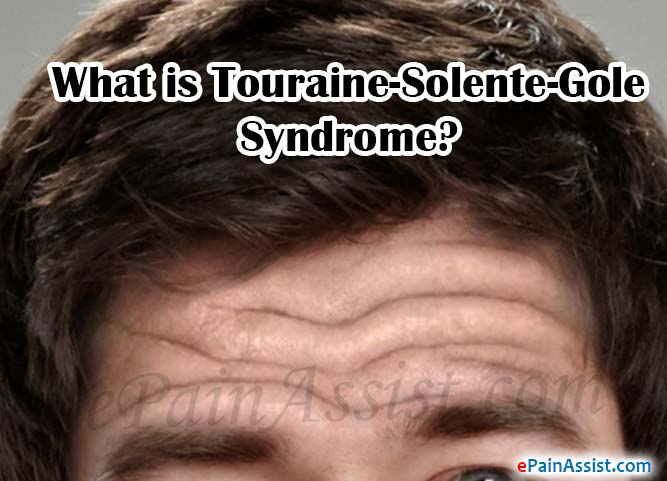What is Touraine-Solente-Gole Syndrome?
Touraine-Solente-Gole Syndrome which is also known by the name of Pachydermoperiostosis is an extremely rare pathological condition in which the characteristic features are distinct clubbing of fingers and extremely thickened facial skin.
An affected individual with Touraine-Solente-Gole Syndrome tends to also have excessive sweating as a result of this condition. Touraine-Solente-Gole Syndrome is a slow growing condition which normally begins in childhood or when a child attains puberty and progresses gradually within a span of about 10 years or so.
As the disease progresses, the affected individual starts to have enlargement of the fingers and toes along with distinct facial features with the skin of the face becoming abnormally thick. There is also development of multiple folds on the scalp. The affected individual also tends to have excessive sweating, a condition called as hyperhidrosis as a result of Touraine-Solente-Gole Syndrome.

What are the Causes of Touraine-Solente-Gole Syndrome?
The exact cause of Touraine-Solente-Gole Syndrome is still a matter of investigation but this condition follows primarily an autosomal dominant pattern meaning that one copy of the defective gene inherited from one parent is good enough for a child to develop Touraine-Solente-Gole Syndrome although in some cases autosomal recessive pattern has also been noted to cause Touraine-Solente-Gole Syndrome.
In majority of the cases, Touraine-Solente-Gole Syndrome is diagnosed based on the clinical features. This condition is primarily seen in males more than it is seen in females.
As of now, no specific gene mutation has been observed that results in the development of Touraine-Solente-Gole Syndrome, although some studies suggest a mutation in gene called 15-hydroxyprostaglandin dehydrogenase has been related to the development of Touraine-Solente-Gole Syndrome although it has not been proven as of yet. Consanguineous marriages are believed to be the cause of most of genetic disorders including Touraine-Solente-Gole Syndrome.
What are the Symptoms of Touraine-Solente-Gole Syndrome?
As stated, the classic presenting features of Touraine-Solente-Gole Syndrome are distinct facial features with abnormally thick skin especially on the face. Clubbing of the fingers and toes is also one of the primary presenting features of Touraine-Solente-Gole Syndrome.
Hyperhidrosis is also one of the symptoms of Touraine-Solente-Gole Syndrome. Having multiple skin folds over the scalp is yet another classic presenting feature of Touraine-Solente-Gole Syndrome.
Additionally, individuals tend to have symptoms like eyelid ptosis, seborrheic dermatitis, ulcers, and abnormal swelling of the hair follicles as a result of Touraine-Solente-Gole Syndrome.
How is Touraine-Solente-Gole Syndrome Diagnosed?
The diagnosis of Touraine-Solente-Gole Syndrome is made clinically with the presenting features of clubbing of the fingers and toes along with thick facial skin and excessive sweating. Apart from this there is no specific test to confirmatively diagnose Touraine-Solente-Gole Syndrome.
How is Touraine-Solente-Gole Syndrome Treated?
The treatment of Touraine-Solente-Gole Syndrome is basically symptomatic. The bone and joint pain caused as a result of abnormalities due to this condition can be controlled by NSAIDs. In some cases, steroids may also be used to calm down the pain.
The facial abnormality as a result of Touraine-Solente-Gole Syndrome can be treated surgically. Medications can also be given to control hyperhidrosis as a result of Touraine-Solente-Gole Syndrome. Genetic testing is of great benefit in people who have a family member dealing with Touraine-Solente-Gole Syndrome.
